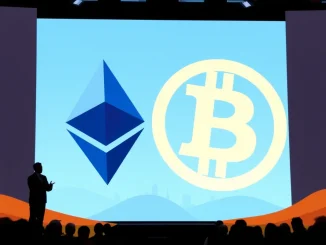
Hold onto your hats, crypto enthusiasts! The stablecoin giant, Tether, has just made a significant move, freezing a total of 18 USDT addresses. This isn’t just a minor blip; it’s a noteworthy event unfolding across two major blockchains: Tron and Ethereum. If you’re invested in USDT, or simply keeping a close eye on the crypto space, this news demands your attention. Let’s dive into what exactly happened, and what it could mean for you and the wider digital asset landscape.
Why Did Tether Freeze USDT Addresses? Unpacking the Blockchain Security Move
According to a report from MistTrack, a blockchain security platform by SlowMist, Tether initiated the freeze on 18 USDT addresses. Eleven of these addresses were on the Tron blockchain, while the remaining seven were on Ethereum. But the million-dollar question is: why?
While Tether hasn’t released an official statement detailing the specific reasons behind this action, freezing addresses is typically a measure taken in response to security concerns or regulatory compliance. Here’s a breakdown of the likely reasons:
- Combating Illicit Activities: Cryptocurrencies, while offering incredible opportunities, can unfortunately be exploited for illegal activities like money laundering, terrorism financing, or sanctions evasion. Tether, as a regulated entity, has a responsibility to prevent its stablecoin, USDT, from being used for such purposes. Freezing addresses suspected of involvement in these activities is a crucial step in maintaining the integrity of the ecosystem.
- Regulatory Compliance: The regulatory landscape for cryptocurrencies is constantly evolving. Authorities worldwide are increasing their scrutiny of digital assets, particularly stablecoins. Tether likely works closely with law enforcement and regulatory bodies. Freezing addresses could be a direct response to a request from these agencies as part of an ongoing investigation or to comply with sanctions.
- Protecting the Ecosystem: Even if an address isn’t directly involved in illegal activities, it might be compromised or associated with a compromised entity. Freezing USDT in such addresses can be a proactive measure to protect the broader crypto ecosystem from potential harm, preventing further illicit fund movement or exploitation.
It’s important to remember that Tether has the technical capability to freeze USDT. This is a built-in mechanism within the smart contracts that govern USDT, allowing Tether to exert control over the stablecoin’s movement when necessary.
Tron and Ethereum: Why These Blockchains?
The fact that the frozen addresses are split between Tron and Ethereum blockchains is significant. These are two of the most popular blockchains for issuing and transacting with USDT. Here’s why this distribution matters:
- USDT on Tron: Tron has become a highly favored blockchain for USDT transactions, especially for users seeking faster and cheaper transactions compared to Ethereum. The higher number of frozen addresses on Tron (11) might suggest a higher volume of suspicious activity or perhaps a more concentrated focus of regulatory scrutiny on the Tron network in this instance.
- USDT on Ethereum: Ethereum, while facing higher transaction fees, remains a cornerstone of the DeFi (Decentralized Finance) ecosystem and a major platform for USDT. The seven frozen addresses on Ethereum indicate that security and compliance concerns are relevant across different blockchain networks where USDT is prevalent.
The simultaneous action across both Tron and Ethereum underscores the broad reach of Tether’s security measures and the need for vigilance across the entire cryptocurrency space.
Impact of Frozen Addresses: What Does it Mean for USDT Holders?
For users directly affected by the address freezes, the immediate impact is clear: their USDT holdings in those specific addresses are now inaccessible. They cannot send, receive, or exchange these funds. This can be incredibly disruptive, especially if these funds were intended for legitimate purposes.
But the implications extend beyond just the directly affected individuals:
- Trust and Transparency: While security measures are necessary, events like these can raise questions about transparency and centralized control within stablecoin systems. Users might wonder about the criteria for freezing addresses and the due process involved. Clear communication from Tether about such actions is crucial to maintain trust in USDT.
- Decentralization Debate: The ability of a central entity like Tether to freeze funds reignites the ongoing debate about centralization versus decentralization in cryptocurrencies. While centralization can enable swift action against illicit activities, it also concentrates power and control, which goes against the core ethos of some within the crypto community.
- Broader Market Sentiment: Major actions by Tether, as the issuer of the largest stablecoin, can influence overall market sentiment. While this particular event is focused on security, it serves as a reminder of the regulatory and compliance pressures facing the crypto industry. The market’s reaction will depend on how Tether communicates and manages the situation moving forward.
Navigating the Waters: Actionable Insights for Crypto Users
So, what can crypto users learn from this situation? Here are some actionable insights:
- Diversification is Key: Don’t put all your eggs in one basket. Diversify your crypto holdings across different assets and platforms. Relying solely on one stablecoin, or holding significant amounts in a single address, increases your risk.
- Understand Regulatory Risks: Be aware of the regulatory landscape in your jurisdiction and the potential impact on your crypto holdings. Compliance measures, while sometimes inconvenient, are increasingly becoming a part of the crypto world.
- Use Reputable Platforms: Transact and store your cryptocurrencies on reputable and regulated exchanges and wallets. These platforms are more likely to have robust security measures and compliance protocols in place.
- Stay Informed: Keep yourself updated on cryptocurrency news and regulatory developments. Understanding the risks and challenges can help you make more informed decisions and navigate the crypto space more effectively.
The Road Ahead: Blockchain Security and the Future of USDT
Tether’s freezing of these 18 USDT addresses is a stark reminder of the ongoing efforts to secure the cryptocurrency ecosystem and combat illicit activities. It highlights the delicate balance between security, compliance, and the principles of decentralization within the crypto world.
As the cryptocurrency industry matures, we can expect to see continued vigilance from stablecoin issuers like Tether and increased regulatory scrutiny. For users, understanding these dynamics and taking proactive steps to manage risk is paramount. The future of USDT and the broader stablecoin market will depend on maintaining trust, ensuring security, and navigating the evolving regulatory landscape effectively. This latest move by Tether, while causing ripples, is ultimately aimed at strengthening the long-term viability and legitimacy of digital assets.



